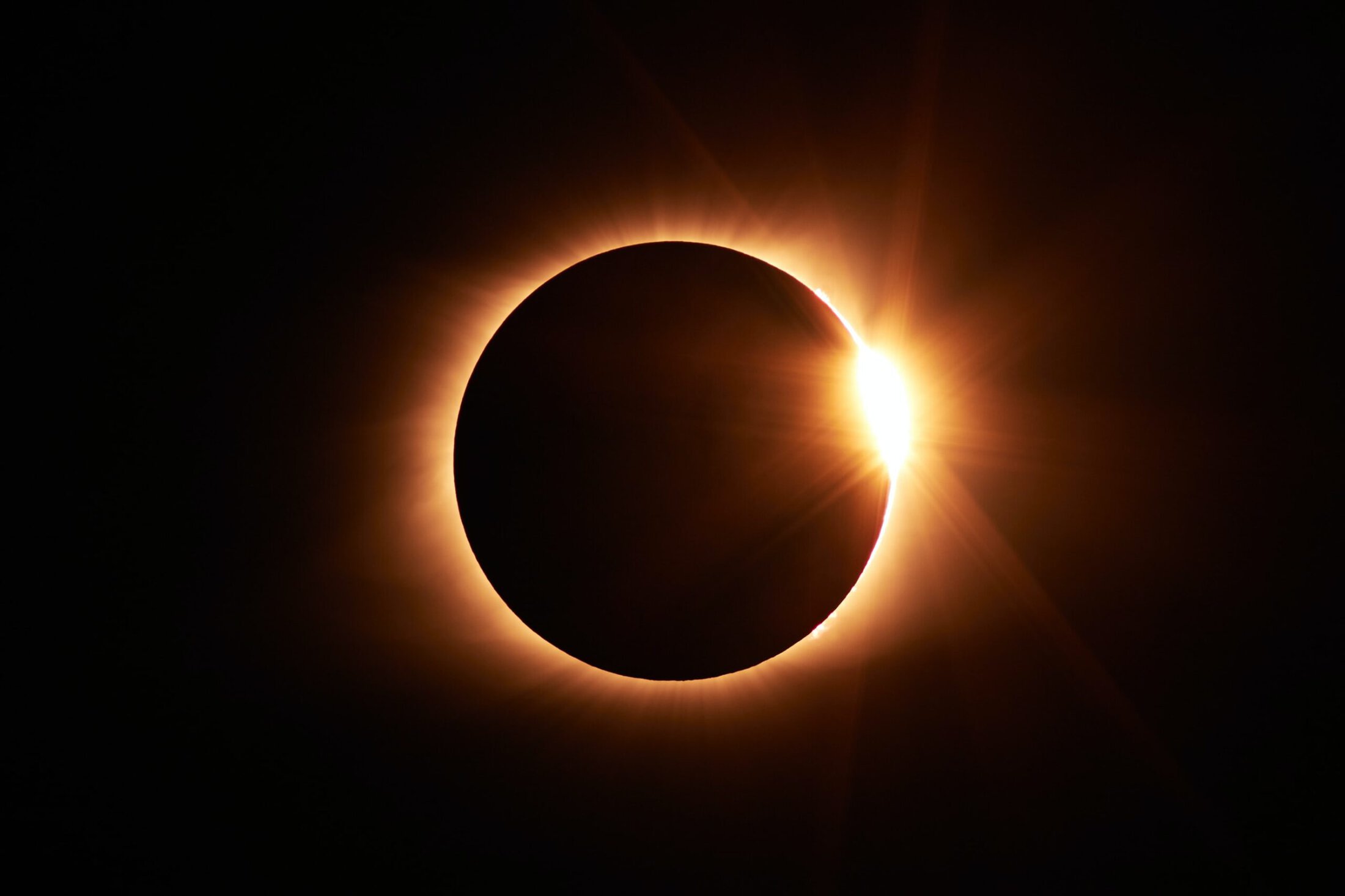
April 8, 2024
A Solar Eclipse is a celestial event that occurs when the moon passes between the Earth and the Sun, temporarily obscuring the Sun’s light either partially or completely from the view of a specific area on Earth. This phenomenon is possible due to the convenient sizes and distances of the Moon and Sun from Earth, which allow the Moon to appear just large enough to cover the Sun’s disc from our perspective. This reveals the Sun’s corona, its outer atmosphere, which is usually invisible to the naked eye. These events not only offer a breathtaking spectacle but also provide valuable opportunities for scientific research, allowing scientists to study the Sun’s corona, its effects on Earth’s atmosphere, and celestial mechanics. Solar Eclipses have fascinated humans for millennia, serving as important cultural events and advancing our understanding of the cosmos.
The upcoming Total Solar Eclipse presents many opportunities for research, teaching, and community engagement, as the path of totality stretches across much of the United States on April 8th 2024. Researchers at the University of Michigan Department of Climate and Space Sciences and Engineering will be studying and observing the Solar Eclipse through outreach campaigns and academic study.
Coronacast 2024 Livestream

During the 2024 Solar Eclipse event, our team will be utilizing advanced computational models in real time to forecast and understand the behavior of the solar corona. The Space Weather Modeling Framework, specifically the Alfvén Wave Solar-atmosphere Model (AWSoM), allows us to simulate the solar atmosphere dynamics accurately. This analysis will enable us to refine our models further and share live updates with the public, enhancing both the educational and experiential aspects of the eclipse.
In an effort to bring the scientific community closer to the public, we will be hosting a livestream on eclipse day to discuss the eclipse and our model predictions with fellow scientists and students. During the event we will be conducting interviews with esteemed scientists from the solar community and can be found on the University of Michigan ClaSP YouTube Channel. The interviews are designed to be accessible to a wide audience, including undergraduate and graduate students, fellow researchers, and the scientifically curious public. Additionally, we will be taking questions live, fostering an interactive, and engaging learning environment.
Educational Outreach: Collaboration with Texas Schools
We have established a collaborative effort with the Arlington Independent School District to educate local students about the solar eclipse. A series of outreach events have been planned for the week of the eclipse to engage students from kindergarten through 12th grade. These activities are designed to spark interest in the fundamental sciences by exploring the mechanics of solar eclipses, the physics of the Sun, the structure of our solar system, and even a glimpse into the life of a physics graduate student. These educational efforts aim to inspire the next generation of scientists by giving them a first-hand look at the practical applications of scientific inquiry and the excitement of space research.
Educational Outreach: Field Trip for Elementary School students
With support from a National Science Foundation Grant, another team at the University of Michigan Department of Climate and Space has planned a field trip for elementary school students and their families to travel to the Path of Totality in Ohio, in collaboration with the Hebrew Day School of Ann Arbor. The field trip will take place on Monday, April 8, 2024, when students in grades K-5 will have the chance to view Totality for the first time, and learn about the Solar Eclipse with our volunteers. This educational activity will also inspire the next generation of scientists by giving them the first-hand experience of witnessing a Solar Eclipse, while also getting an introduction to the science behind the Total Solar Eclipse.
SunRISE Mission: SunRISE Ground Radio Lab Campaign
In collaboration with the University of Michigan and NASA, high schools across the United States are also participating in a radio science campaign connected to NASA’s Sun Radio Interferometer Space Experiment (SunRISE) mission, due to launch in 2025. The SunRISE Ground Radio Lab (GRL) engages citizen science using a multi-frequency radio telescope to observe radio emissions from Jupiter, the Sun, the Milky Way Galaxy, and Earth. Students participating in the project search for solar radio bursts during space weather events. The data high school students are collecting supplements the work of the SunRISE Mission, and the next major campaign will be held during the Total Solar Eclipse, on April 8, 2024.
Visit the SunRISE Ground Radio Lab website: https://sunrise.umich.edu/
Read more in Science: https://www.science.org/doi/10.1126/science.adk1481
More information about Solar Eclipses
The Solar Eclipse marks a unique opportunity for observation and scientific research, with impacts spanning from the temperature and local weather to birds and other wildlife. Listed below are more resources on the Eclipse, including historical accounts, maps for the Path of Totality in 2024, future dates for upcoming Eclipses, and articles on the rare phenomena.
- NASA Resource on Eclipses, Future Eclipses and Eclipse Stories
- U-M Collections Magazine: How Solar Eclipses Have Played a Role in Scientific Discovery
- Audubon Society: A Total Solar Eclipse Is Coming. How Will Birds and Other Wildlife React?
- WTOL11 News: Will the temperature drop during totality? How the total solar eclipse can affect the weather
- NASA News: The Impact of Solar Eclipses on the Structure and Dynamics of Earth’s Upper Atmosphere
- SOHO (Solar and Heliospheric Observatory): Latest images of the solar surface, atmosphere, and corona